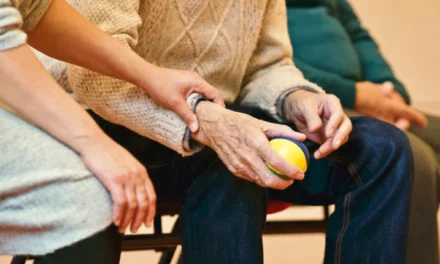Des Holden, Chief Executive Officer, considers the impact of Covid on the health and social care system, how KSS AHSN contributed to the Covid-related needs of its ICSs, and the lessons learned around the spread of innovation.
He also outlines how KSS AHSN’s commitment to co-design will ensure that it can accurately measure impact, and considers the need for a varied approach to meet the needs of the different communities across the organisation’s operating region.
A data-driven approach to health inequalities is set to feature heavily in driving KSS AHSN’s work this financial year, and Des explores how this will support his future ambitions for KSS AHSN.
What are some of the delivery highlights from 2021/22?
What stands out for me is the way we contributed to the specific needs of our ICSs, and the population we serve, particularly around Covid vaccinations for those who were not in the first tranche and were more difficult to accommodate.
We were able to plan and deliver an approach to reach those who were housebound and arrange for them to receive their vaccine. From a population point of view this represented a relatively small percentage of households, but from a risk point of view it was a significant group.
Working with Wessex and Oxford AHSNs on the COVID Oximetry @home project, we were able to support primary care teams to get oximeters into the hands of people who had tested positive for Covid, and were not sick enough to need to go to hospital, but had the potential to become very poorly very quickly. All three of our ICSs ran this project differently, but we were able to support their ambitions, and provide peer support from with the national network of AHSNs.
That approach maximised the impact of innovation to keep people safe in their own home in communities across the region, irrespective of postcode or demographics. As part of this project there was a lot of work, particularly with the national clinical directors, around the presentation of the innovation, and information on how to use it and where to seek help if the numbers were of concern, and on the platform which would help GPs and PCNs manage the logistics of the programme. A particular aim was to build trust in the technology so that it was acceptable to as many people as possible.
What have you learnt during the year?
A key learning is around how we measure impact. It’s not enough to think, ‘How am I going to spread this?’ and then when I’ve spread something, ‘How am I going to measure it?’ and then when I’ve measured it, ‘How am I going to talk about impact?’.
You cannot do it in sequence like that. You have to have a game plan that takes you to the end-point of telling the story of how the public benefited. You don’t think about impact or implementation late in the project. It has to be there from the word go.
By understanding where you think the pressure points are going to be, you can work them through from the beginning, by co-designing the approach. This is valuable learning that has come out of the NIHR Applied Research Collaboration Kent Surrey and Sussex (ARC KSS) during the pandemic, and we’re taking that approach into all of the work we do. Trying to retrofit how you measure impact at the end of a project is much harder work and less likely to give you a genuine, or useful, result.
And then I think we’ve also learned the value of varying our approach to make sure that people who are particularly at risk are supported. We’ve seen that when trying to reach different groups, it’s vital that messaging is varied. There is no one message that can reach all groups, and it mustn’t be assumed there is. You need a range of approaches to successfully increase the breadth of benefit that innovation can bring.
What are your plans for this financial year?
It’s an interesting year, as it will be my first full year as Chief Executive Officer, and also the last year of our current five-year licence. We’re going to be looking more at the learning that has come from Covid, particularly around the demand and capacity mismatch that the NHS is facing.
There is a range of challenges from safety to access and emergency and elective care, for mental as well as physical health, and we’ll be looking at how we can deliver on that. How does innovation, or spreading the best offerings already known to the AHSN Network, enhance self-care, or workforce capacity, and prevent increasing acuity? What can be delivered at home, what can be delivered in community, and what has to be delivered in the hospital?
Not everyone has the same access to existing care, and the same is true of innovation. This ‘unfairness’ may be a significant hook for people in need of, and in giving care. We are going to have a year of making good the pledge that the transformation of lives that comes from our work with system partners is about reaching everyone, and working harder to reach everyone. This will be within the Core20PLUS5 work on reducing health inequalities that we do with our ICSs, but more broadly in the local delivery of national work too.
I’m also particularly pleased that we’ve been asked by NHS England to lead on a data-driven approach to health inequality. This is an approach we’ve been taking for a couple of years, so it’s a great opportunity to build on that and work with other partners.
So we’ll be working with Unity Insights and the integrated datasets across Kent, Surrey and Sussex. There’s no doubt in my mind that the levelling-up agenda will be delivered by clinicians and clinical leaders, empowered by data. I think we can help support them to transform the care that they would like to see, and transform the outcomes that care delivers.
What are your ambitions for your work over the next two to five years?
I don’t know that five years is enough! My big thought is that partners will work together and bring their individual expertise to the table in improving the lot of citizens.
I’m a big fan of ICSs and of bringing the local authority, third sector, voluntary sector together, drawing on the combined expertise and budget to enable care to change.
In that context, I think we’ve got a lot to offer in terms of supporting innovators and the system to innovate. The national innovation pipeline allows us to bring the best of what’s available in other regions to the problems that the South East faces. Our key role in supporting the implementation of ARC KSS research findings, and our partnership with the NIHR Clinical Research Network and Research Design Service should help make research capacity available to ICSs who want specific questions answering – an important ingredient for the transformation agenda.
When I look at Core20PLUS5, the most interesting part may be the PLUS. We have a large coastline, and there’s a lot of appreciation that coastal communities are disadvantaged. So we will be able to work with partners, ARC KSS, higher education institutes and industry, to try and explore something bespoke that addresses the problems of coastal communities.
In five years I’d like to be able to look back and say we had a plan, we knew the partners that we needed, and we were able to excite them. We got the permissions from the ICS is to work with them, and partners, to make a difference in key areas.
Our access to and use of data let us follow process and outcome metrics, and enabled us to describe impact. It was successful, and we were asked to do more and more driven by data and driven by impact co-designed with the public. Those are the ingredients that will form our work over the next five years.





